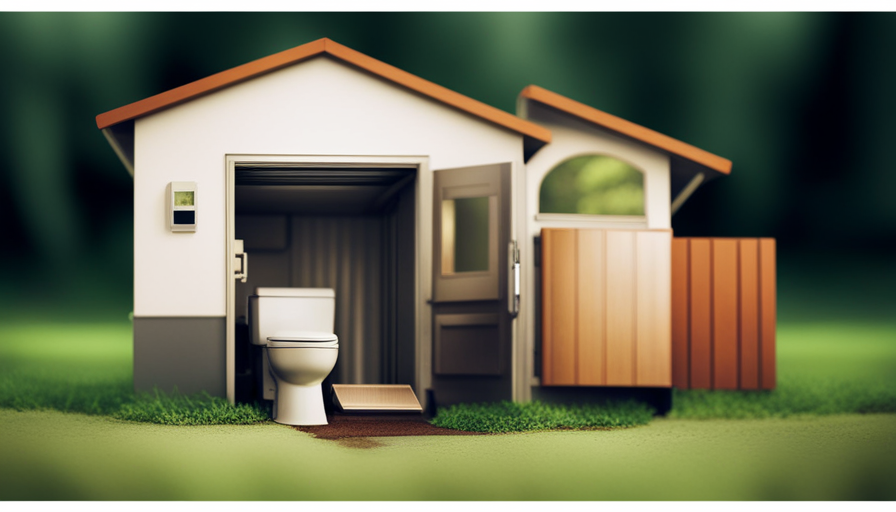Have you ever wondered where those small centipedes in your home come from? Let me enlighten you with a surprising fact about their origin.
These creepy crawlers, with their countless legs and lightning-fast movements, have been around for millions of years. They are not some recent invasion of our homes, but rather ancient creatures that have adapted and survived through the ages.
House centipedes, scientifically known as Scutigera coleoptrata, are fascinating creatures that thrive in a variety of habitats, including damp basements, bathrooms, and even attics. They play a crucial role in controlling populations of other pests, such as spiders, ants, and cockroaches.
While their appearance may be unsettling to some, house centipedes are harmless to humans and prefer to avoid direct contact whenever possible. They are skilled hunters, using their lightning-fast speed and venomous jaws to catch their prey.
In this article, we will explore the natural behavior and habitat of house centipedes, as well as their lifespan, reproduction, and why they enter our homes. We will debunk common misconceptions and myths surrounding these creatures and provide you with effective prevention and control methods.
So, let’s dive into the fascinating world of house centipedes and appreciate the benefits they bring to our ecosystems.
Key Takeaways
- House centipedes, scientifically known as Scutigera coleoptrata, have been around for millions of years.
- They thrive in damp basements, bathrooms, and attics and play a crucial role in controlling populations of spiders, ants, and cockroaches.
- House centipedes are harmless to humans and prefer to avoid direct contact. They are skilled hunters using speed and venomous jaws to catch prey.
- Prevention and control methods for house centipedes include reducing moisture, sealing cracks, and keeping the home clean and decluttered.
Habitat and Natural Behavior
Imagine yourself walking into a dimly lit basement filled with damp corners and stacks of old newspapers, where tiny house centipedes scuttle along the walls, searching for insects to feast on. These remarkable creatures, known scientifically as Scutigera coleoptrata, play a crucial role in the ecosystem as both predators and prey.
As predators, house centipedes feed on a variety of insects including spiders, silverfish, and ants, effectively controlling their population. This predator-prey relationship helps maintain the balance of the ecosystem by preventing the overpopulation of certain insect species.
Additionally, house centipedes themselves serve as prey for larger predators such as spiders and birds. Their ability to adapt to a wide range of environments, coupled with their efficient hunting skills, allows them to thrive in diverse habitats.
Now let’s delve into the fascinating aspects of their lifespan and reproduction.
Lifespan and Reproduction
To truly understand the lifespan and reproduction of these fascinating creatures, picture yourself stepping into a world where minuscule beings emerge and multiply. House centipedes have an average lifespan of about 3 years, although some individuals have been known to live up to 7 years in ideal conditions. These arthropods have a unique mating behavior. The male house centipede constructs a small web-like structure on the ground where he deposits a spermatophore. He then entices a female to approach and pick up the spermatophore, fertilizing her eggs in the process. The female will lay her eggs in a secluded location, such as cracks in walls or under floorboards. She can produce up to 150 eggs in a single batch. Now, let’s delve into the intriguing topic of why house centipedes enter homes and how to deal with them.
Why House Centipedes Enter Homes
Curious about the reasons behind those unexpected visitors? Well, brace yourself for the unsettling truth. House centipedes invade homes for a few key reasons:
-
Food: These fast-moving arthropods are attracted to the abundance of insects and spiders in our homes. They rely on this food source to survive and reproduce.
-
Moisture: House centipedes are moisture-loving creatures. They seek out damp areas like basements, bathrooms, and crawlspaces.
-
Shelter: Cracks, crevices, and clutter provide the perfect hiding spots for house centipedes. They can easily find refuge in these areas.
So, how can you get rid of these creepy crawlies? Here are a few tips:
- Reduce moisture by fixing leaks and using dehumidifiers.
- Seal cracks and gaps to prevent their entry.
- Keep your home clean and decluttered to eliminate their hiding spots.
Now that you know why house centipedes invade homes and how to get rid of them, let’s debunk some common misconceptions and myths about these fascinating creatures.
Common Misconceptions and Myths
If you’ve ever encountered one of these swift creatures, don’t be fooled by the common misconceptions and myths that surround them. House centipedes are often misunderstood and feared, but they actually serve a beneficial purpose in our homes. To help you better understand these fascinating creatures, here is a table that highlights their diet and predators:
| House Centipede Diet | House Centipede Predators |
|---|---|
| Insects | Spiders |
| Ants | Silverfish |
| Termites | Cockroaches |
| Bed bugs | Earwigs |
| Moths |
House centipedes play a crucial role in controlling the population of other household pests. Their diet consists mainly of insects like ants, termites, bed bugs, and moths. They also prey on spiders, silverfish, cockroaches, and earwigs. By keeping these pests in check, house centipedes contribute to a healthier and more balanced ecosystem inside our homes.
Understanding the house centipede’s diet and predators can help us appreciate their presence and the important role they play. Now, let’s explore prevention and control methods to ensure a harmonious coexistence with these beneficial creatures.
Prevention and Control Methods
Take a moment to consider the power of prevention and control methods when it comes to maintaining a peaceful coexistence with these helpful critters. House centipedes have natural predators that can help keep their population in check, such as spiders and certain types of birds. Encouraging these natural predators to thrive in your home can be an effective way to prevent an infestation.
Additionally, there are several DIY remedies that can be used to control house centipedes. These include sealing cracks and crevices, reducing moisture levels, and keeping your home clean and clutter-free. By implementing these prevention and control methods, you can minimize the presence of house centipedes in your home and create a more harmonious living environment.
Appreciating the benefits of house centipedes, such as their ability to control other pests, will be discussed in the next section.
Appreciating the Benefits of House Centipedes
Imagine the wonders that await you when you discover the surprising benefits of having these fascinating creatures as your tiny roommates. House centipedes may seem creepy, but they play a crucial ecological role in your home.
Here are three reasons to appreciate their presence:
-
Pest control: House centipedes are expert hunters, feasting on spiders, cockroaches, termites, and other unwanted pests that can infest your home. They’re a natural form of pest control, keeping your living space free from harmful insects.
-
Air quality: These centipedes help maintain a healthy environment by scavenging dead insects and reducing the risk of mold and bacteria growth. This contributes to better air quality, especially in damp areas like basements.
-
Ecosystem balance: House centipedes are part of a balanced ecosystem. They serve as a food source for other creatures, such as birds and larger insects. By supporting the centipede population, you’re promoting biodiversity in your home.
Embrace the benefits of house centipedes and appreciate the ecological role they play in your living space.
Frequently Asked Questions
Are house centipedes harmful to humans?
House centipedes aren’t harmful to humans. They don’t pose a threat to our health or well-being, contrary to popular belief. These creatures are actually beneficial as they feed on other pests like spiders, cockroaches, and termites. Understanding their behavior can help us coexist with them peacefully. To prevent house centipede infestations, it’s important to maintain a clean and dry environment, seal any cracks or openings in the house, and reduce clutter that may provide hiding places for them.
Do house centipedes bite or sting?
Yes, house centipedes can bite, but their bites are typically harmless to humans. They have venomous claws that they use to immobilize their prey, which consists of other insects like cockroaches, spiders, and silverfish.
House centipedes play an important role in controlling pest populations in your home. To prevent them from entering, you should eliminate their food sources, such as keeping your home clean and free of other insects, sealing cracks and crevices, and reducing moisture levels.
Can house centipedes cause any damage to the home?
House centipedes, though creepy-looking, actually provide benefits as they prey on other household pests. They don’t cause any damage to the home. In fact, they’re quite helpful in controlling populations of spiders, cockroaches, and other insects.
However, if their presence becomes bothersome, there are ways to get rid of them. Keep your home clean and clutter-free, seal off entry points, and reduce moisture levels to discourage their presence.
What attracts house centipedes to homes?
To prevent house centipedes from entering your home and repel them naturally, there are a few effective strategies. First, keep your home clean and free of clutter, as centipedes are attracted to dark and damp areas.
Seal any cracks or crevices in the walls, floors, and foundation to prevent their entry. Additionally, use natural remedies like essential oils or vinegar sprays to deter house centipedes.
These methods will help create an environment that’s less appealing to them and reduce the chances of infestation.
Are house centipedes found all over the world?
House centipedes are indeed found all over the world, making them a globally distributed species. They can be found in a variety of habitats, including homes, gardens, and natural environments. These fascinating creatures have adapted to various climates and can survive in both tropical and temperate regions. Their ability to thrive in diverse environments is one of the reasons why house centipedes have such a wide global distribution.
Conclusion
In conclusion, house centipedes may be small and creepy, but they play an important role in our homes. Just like the centipede, we all have our unique qualities that sometimes make us seem strange or unwelcome. However, by understanding and appreciating the benefits that these creatures bring, we can learn to coexist peacefully.
So, let’s embrace the house centipede and its ability to control other pests, and remember that sometimes, the things that seem odd or different can actually be valuable allies.
Hi, I’m Emma. I’m the Editor in Chief of Tiny House 43, a blog all about tiny houses. While tree houses are often associated with childhood, they can be the perfect adult retreat. They offer a cozy space to relax and unwind, surrounded by nature. And since they’re typically built on stilts or raised platforms, they offer stunning views that traditional homes simply can’t match. If you’re looking for a unique and romantic getaway, a tree house tiny house might just be the perfect option.










